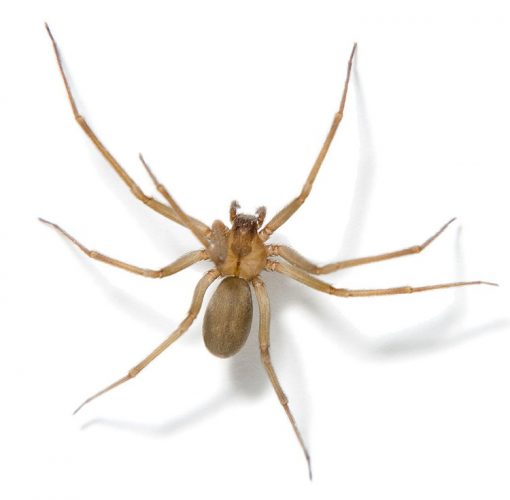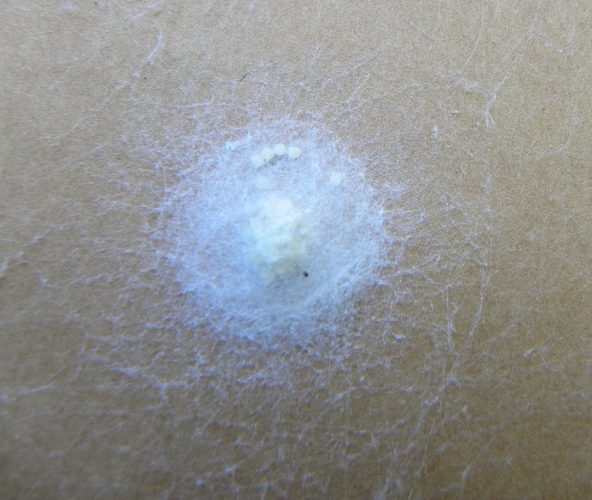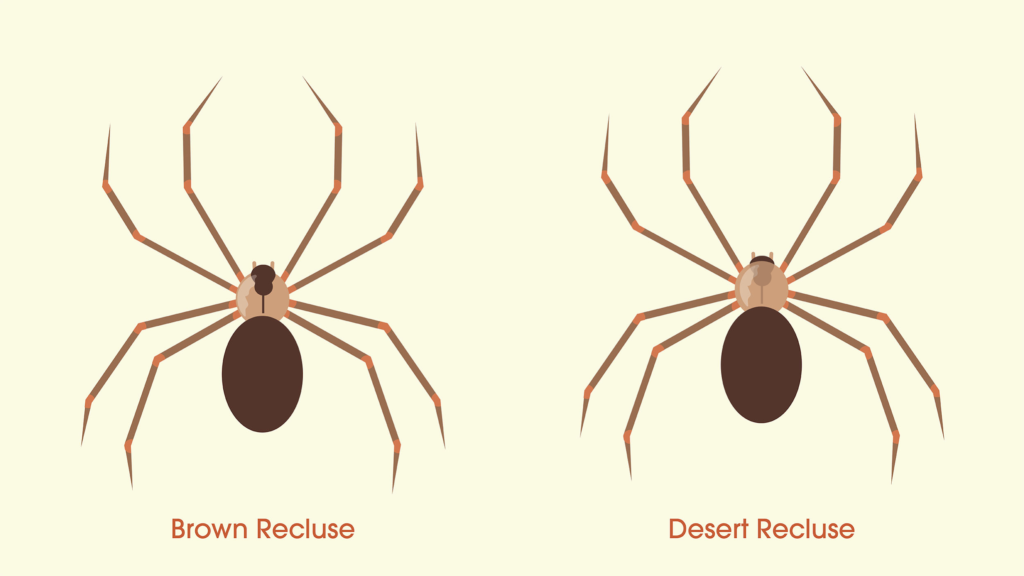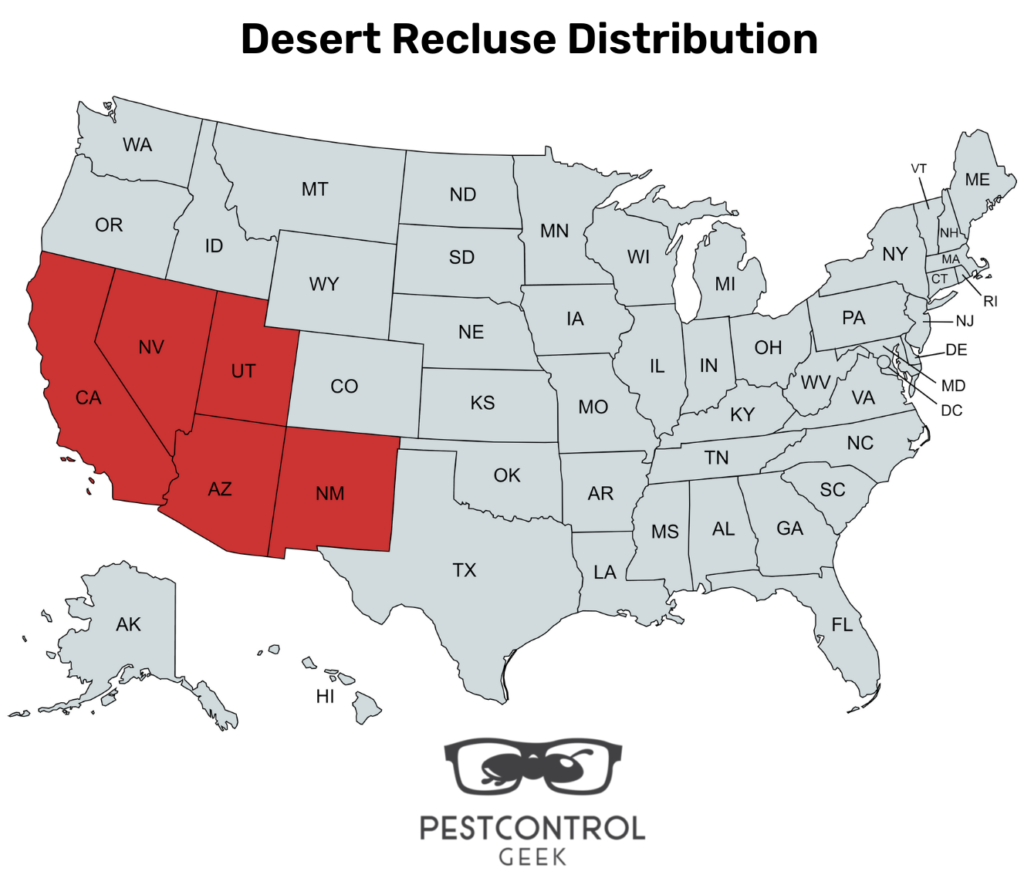The desert recluse strikes fear in most people who’ve heard of it.
Not only are these spiders big and scary compared to most household spiders they are also venomous.
To make matters worse, they are often hard to identify due to their likeliness to many other spiders.
Don’t stress. I’m here to help you feel safe walking around your home and yard again.
In this post, I will help you identify the desert recluse spider and give you eight effective ways to get rid of them.
Let’s get started.
How To Identify Desert Recluse Spiders
What Do Desert Recluse Look Like?

- Size: Adult desert recluse spiders are around ½ inch in length. They often look larger due to their legs having a span of 1 ½ inch to 2 inches.
- Color: Desert recluse can vary from tan, yellowish, or reddish-brown. Their abdomen is typically lighter than their body, taking on a beige or light brown color.
- Pattern: Desert recluse has a signature fiddle-shaped marking on their abdomen that is slightly darker than their abdomen.
- Eyes: Desert Recluse spiders are unique compared to other spiders because they have six eyes rather than eight eyes. Their eyes are grouped in pairs of three eyes.
- Note: While desert recluse spiders are known for their fiddle-shaped marking, this symbol can vary dramatically in intensity. It can be very apparent in certain desert recluse spiders, while in others, it might not be almost non-existent.
What Do Desert Recluse Eggs Look Like?

The desert recluse creates egg sacks like many other spiders. The egg sacks are silk round or oblong balls that are attached to the surface with a flat web.
Desert recluse egg sacs are typically an off-white to cream color and can contain around 50-100 eggs.
You will most likely find these egg sacs between May and June but can appear slightly earlier or later.
How To Identify A Brown Recluse From Other Spiders?
Sometimes differentiating between a brown recluse and another spider is difficult.
This is especially true when they are the same color and around the same size.
Fortunately, there are some key characteristics that you can look for to avoid confusing other spiders with a brown recluse.
Below are characteristics that brown recluse spiders don’t have. If the spider in question has any of these features, it’s not a brown recluse spider.
- Most species of spider have eight eyes compared to the six eyes of the brown recluse spider.
- Patterns, stripes, or bands on a spider is a clear indication that it’s not a brown recluse.
- They are missing the Violin mark at the top of their head. And they have other patterns on colors on the cephalothorax.
- Large thin spines on their legs or body. Brown recluse spiders don’t have any visible spines.
Desert Recluse vs Brown Recluse: How To Tell Them Apart?

One of the most common questions is how do you differentiate desert recluse and brown recluse spiders.
Both desert recluse spiders and brown recluse spiders both have necrotic venom. This means that their bite is painful, and it damages and attacks the tissue and skin surrounding the bite, causing a necrotic lesion.
Desert recluse spiders and brown recluse spiders can look almost identical in terms of size and color.
One way to tell them apart is their signature fiddle marking on their cephalothorax. This marking is typically much more apparent in brown recluse spiders, while the marking can vary in intensity on desert recluse spiders.
Another way to differentiate them is where they are found. Brown recluse spiders are found throughout the United States. On the other hand, desert recluse spiders are only found in five desert states in the West Coast.
Where Do Brown Recluse Spiders Live (Distribution)?

The desert recluse is most abundant in the Sonoran and Mojave deserts. Since the Mojave desert spans multiple states, these spiders can be found in California, Nevada, Utah, Arizona, and New Mexico.
They tend to prefer a hot and humid climate. This means you will not find these spiders in every location of each state. For example, in California, the desert recluse is typically found away from the coast and Nevada and California.
Outside of the United States, the desert recluse spider is commonly found in Mexico. In South America, the desert recluse is often confused with the Chilean recluse found in Peru, Ecuador, Argentina, Brazil, and Uruguay.
How To Get Rid of Desert Recluse Spiders
1. Keep Your Yard Well Maintained
When it comes to desert recluse spiders keeping your yard clean and well maintained is important.
Desert recluse spiders like to hide underneath rocks and debris in yards. To help reduce the chances of a desert recluse spider invading your home, make sure to keep all the yard debris cleaned.
Yard debris is anything that should not be lying around in your yards, such as old grass clippings, fallen branches, piles of leaves, or old furniture.
It’s important that you pick up these items to reduce the number of hiding spots of desert recluse spiders.
Another thing you want to do is reduce the amount of lawn decorations, planters, and furniture to a minimum.
Unfortunately, items like these provide an ideal hiding place for desert recluse spiders.
2. Store firewood properly
One of the most common areas that desert recluse spiders end up hiding is between and on firewood.
To avoid attracting desert recluse spiders to your firewood, you want to store it inside a firewood shelf and cover.
These shelves will store your firewood off the floor and inside an enclosed bag to prevent them from getting access.
Another recommendation is that you keep your firewood away from your home. If desert recluse spiders are hiding within your firewood, at least it will be away from your home.
Firewood is one of the main reasons that desert recluse spiders end up indoors. They hitchhike their way indoors; otherwise, in most cases, they remain outside.
Firewood is also another reason that desert recluse spiders bite people. Unknown people will reach for their firewood, not aware that a desert recluse is hiding on it.
3. Seal All Entry Points
Another effective way to get rid of desert recluse spiders is to seal all potential entry points.
Although desert recluse spiders don’t frequent inside homes, this is an easy step to take to keep your home safe.
It’s recommended that you seal all entry points on any outside structures as well and not just you’re home.
This includes any garages, sheds, or second houses that you may have on your property.
In many cases, although desert recluse spiders don’t hide inside homes, they are often found inside sheds due to the clutter and easy hiding location.
The easiest way to seal all entry points is to use caulk to cover any holes. Caulk is easy to apply, and it dries quickly.
You can also install door sweeps to prevent the desert recluse from crawling under your doors.
The final thing you can do is weatherstrip your home. Although, desert recluse spiders look big. They can fit into small openings.
You want to weatherstrip around your door and window sills. This will ensure that spiders can’t sneak into your home through any wall voids or gaps.
Below are some areas that you should ensure are sealed to prevent desert recluse spiders from entering your home.
- Weatherproof doors and windows
- Apply doors sweeps to all doors
- Install screen doors if you like to leave your doors open
- Fix or replace screen doors
- Apply bugs screens to vents on basements and attics
- Apply caulk to any cracks, crevices, or holes inside and outside your home
Taking all the steps above will make it much harder for spiders to enter your home. The next several steps will help you address the spiders that are inside your home.
4. Eliminate other Pests Around Your Home
Eliminating another pest around your home is an important step to getting rid of desert recluse spiders. This is because, like most insects, desert recluse spiders will live in areas where there is plenty of food.
Desert recluse spiders are hunting spiders. This means that although they build webs, they don’t use them to catch their food. They are active hunters and will feed on any small insects that they can get their hands on.
The most common insects that desert recluse spiders eat are:
- Cockroaches
- Crickets
- Silverfish
- Ladybugs
- Beetles
- Flies
- Moths
- Other small, soft-bodied insects
If you suspect these insects around your home, then you should take action to get rid of them.
The best way to eliminate other common pest issues is to use a broad-spectrum insecticide on the exterior of your home.
This will eliminate other pests and desert recluse spiders as well.
The most effective insecticide is a residual insecticide that will provide coverage for three to six months after the initial application.
5. Apply Insecticide Outdoors
It’s unnecessary to apply insecticide indoors for desert recluse spiders since they commonly live outdoors. It’s only necessary to apply insecticide indoors if the infestation is large.
The most effective type of insecticide for brown recluse spiders is a residual spray. A residual spray provides a lasting effect that will kill any insects that come into contact with the insecticide between 3 and 6 months later.
When applying insecticide spray, you want to target your foundation as well as 3 feet upwards from the floor on your walls.
You should also apply the residual spray around doorways and windows to prevent spiders from trying to sneak into your home.
You should also spray any outside structures to prevent brown recluse spiders from making their home inside those. This includes sheds, garages, and patios.
You can also apply the residual insecticide to your grass, plants, and other areas outside your home.
6. Use Glue Boards To Trap and Monitor
Another way you can get rid of desert recluse spiders is by using glue boards.
Glue boards are an effective method you can use to monitor your desert recluse population.
Since desert recluse spiders typically live outdoors, these glue boards need to be placed outdoors.
Most glue boards are not made for outdoor use because they may fly away or it will get very dirty due to the wind blowing around debris.
One way to avoid this is to place it inside a small cardboard box. Then make a small hole on each side of the box to give the spider access.
I recommend keeping this hole relatively small to avoid other insects from getting inside.
Once they are set, you can close the box and place something heavy on top to prevent it from moving.
To increase the appeal of the trap, you can place a live or dead insect on the glue board. The goal is that the insect will attract the desert recluse to the trap.
You want to place multiple traps at different locations in your yard,
This will help you determine how large the infestation is and what area has the highest activity.
Check these traps weekly and replace any that have caught any spiders or are dirty with debris.
7. Introduce Natural Predators
One way to get rid of brown recluse spiders naturally is to introduce their predators.
Since desert recluse spiders are dangerous due to their painful bite, you can introduce a safer predator alternative.
Remember, when introducing natural predators, these insects will likely end up infesting outside your home in place of the desert recluse spiders.
This means that it’s important that you choose a predator that is not dangerous to the health of your family or pets.
Some common natural predators for desert recluse spiders that are safe to introduce outside your home include:
- Wolf spiders
- Praying mantis
- Wrens
- Chickens
- Centipedes (non-venomous centipedes)
- Lizards
I would recommend letting chickens roam your yard for several weeks to a month.
This should help you get rid of many of the insect problems you have around your home, including desert recluse spiders.
8. Use Diatomaceous Earth
Diatomaceous earth is a naturally occurring rock. DE is safe for humans and other large animals but deadly to small insects such as spiders.
The DE will destroy their exoskeleton and cause them to dehydrate.
You can apply a DE slurry around the exterior of your home and to your garden.
A DE slurry involves mixing DE with water and using a pressurized spray to apply it to any surface you suspect the desert recluse.
Once the DE dries, any insects that contact it will begin to feel the effects.
DE causes a slow death, but over time, with reapplication, you can eliminate entire insect populations.
For DE to remain effective, it must stay dry after application. If you have automatic sprinklers or it rains, you should reapply the solution.
Remember, when applying this to your yard, it will inadvertently kill other small insects with exoskeletons as well.
One huge benefit is that DE is non-toxic. It’s safe to use around humans, children, and in gardens without posing any serious dangers.
Frequently Asked Questions (FAQ)
How Long Do Desert Recluse Spiders Live?
Desert recluse spiders typically take approximately one year to reach adulthood. After they reach adulthood, they can live for as long as two to four years.
Studies show that in ideal conditions, the desert recluse spider can live as long as ten years.
Do Desert Recluse Spiders Bite?
Yes, desert recluse spiders bite. They are one of the few spiders that have a dangerous bite in the United States.
The desert recluse spider has a necrotic bite. This means that the bite attacks any surrounding skin and tissue, causing a necrotic lesion. These lesions cause open sources that can be painful and uncomfortable.
One of the worst parts about the desert recluse spider bite is that the lesions can take a long time to heal. In severe cases, their bites can cause headaches, nausea, abdominal pain, and fever.
Are Desert Recluse Spiders Dangerous?
Yes, desert recluse spiders are dangerous because they do bite. Their bites can cause necrotic lesions that take a long time to heal and are painful.
In most cases, their bites are not fatal, but they can lead to medical complications that get much worse in severe cases.
While desert recluse spiders are not aggressive, they will bite if they feel threatened.
What Spiders Look Like Desert Recluse Spiders?
Desert recluse spiders, unfortunately, have a very generic appearance. As a result, many spiders often get confused for desert recluse spiders.
Some of the most common spiders that get mistaken for desert recluse spiders include:
- Brown recluse spiders
- Spitting spider
- Orb weavers
- Funnel spiders
- Hobo spiders
- House Spiders
- Wolf spiders
- Huntsman spiders
What are the symptoms of a Desert Recluse Spider Bite?
Typically the first sign of the desert recluse spider bite is mild pain and a small mark. In some cases, people may not feel any pain or see any visible signs immediately after the bite.
After 8 hours to several days you will begin to experience additional symptoms as the venom begins attacking the tissue and skin around the bite
- Pain around the bite
- Redness or swelling around the bite
- A deep sore or ulcer forming on the bite areas
- Skin turning purple at the location of the bite
- Blistering
- Open wound starting to form
In severe cases, other symptoms can begin to occur as well:
- Nausea
- Headache
- Vomitting
- Fever
- Joint pain
- Weakness
- Siezures
- Coma
If any of these symptoms begin to occur you should seek immediate medical attention to prevent any complications.
Does Vinegar Kill Desert Recluse?
Yes, vinegar can kill spiders buts it’s not an effective solution. First, you typically need to apply it directly to the spider to see any results.
Second, in most cases traditional vinegar is not strong enough especially after diluting it with water. You will need to purchase at least a vinegar with a 30% acid concentration but the higher the concentration the more effective it is.
What Attracts Desert Recluse Spiders?
Desert recluse spiders are typically attracted to three things: food, water, and shelter.
If there are many insects around your home this can attract desert recluse spiders.
If there is excess moisture or areas of high humidity then this can also attract desert recluse spiders.
Finally, if your yard provides plenty of hiding spots it will attract desert recluse spiders. A unkept or cluttered yard provides plenty of hiding spaces that will help the desert recluse spider hide and hunt its food.
